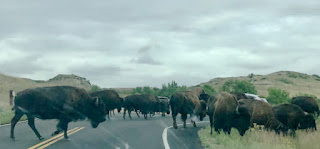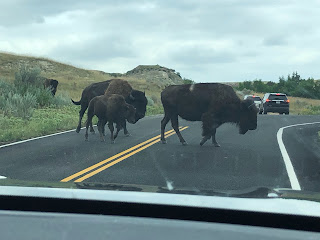Spearfish Canyon
Spearfish Canyon, 8x10
I DECIDE TO VISIT Spearfish Canyon on a day when Carol Baney is digging for fossils and I am on my own.
The canyon, and the drive down into it, is one of the scenic attractions of the South Dakota Black Hills, and I see why. The road is lined by towering crags and spires, with pine trees and other plants growing from and around them.
Over the centuries, rivers and streams carved the canyon and still run today, making waterfalls that are visible from the road, and from hiking trails that cross the area.
One of the most visible and well-known of the Spearfish Canyon waterfalls is Bridal Veil, which is running abnormally thinly because of the drought that is changing life in the west and southwest.
In South Dakota, according to drought.gov, 68 percent of the land is abnormally dry. Over 39 percent of the state, drought has had an impact on grain crops and has stressed livestock. Severe drought has hit 7.8 percent of the state, and extreme drought 2.7 percent.
All that being said, almost as soon as I research and write this from a spot in North Dakota, a friend Carol met on the dig tells her that there are tornado sirens in Belle! Another friend, who is out on the dig, tells Carol that they got the warning at the site and drove all the way to Rapid City to get out of the tornado area.
Here's a photo Patty McFarlane, the friend who had stayed in Belle, posted on Facebook, of the storm that night. Wow! Glad we had already left.
***
Best Bison Parade Ever!
ON THE DAY we leave South Dakota, we find a treasure trove of sunflower fields in.... North Dakota! (Next blog posting!). I paint and paint, and while I am involved, Carol finds that Theodore Roosevelt National Park is not so far away.
Well, it is about an hour and a half away, and that's an hour and a half in the wrong direction, but we decide to go. Yes, it will be a ridiculously long day, but we have a hotel reservation already, (several hours to the east) and so, off we go, west, nearly to the Montana border.
On the way, we become a little convinced that we will drive all this way for nothing. We will get there, and there will be no animals, no bison, no antelope, not even any deer, nothing.
And when we arrive, we start on a 42-mile scenic loop, see nothing, and then find that the road is closed.
What???
We turn around and take a right toward Wind Canyon Trail, the only option open to us. And there, even from a distance, we see them, a line of bison crossing the flats, another lumbering down a big hill, and all crossing right in front of us and about 10 other cars, and walking up the paved road toward another pasture.
This time, the bison are in what appear to be family groups, with a male, a female and a young bison, or "red dog." There seem to be no unattached males, and in fact, the only one we see is shown in the final photo above. He is miles away from the herd, grazing alone, relatively close to the entrance to the park.
The bison parade lasts for 45 minutes or more, and must include 200 animals minimum. It is extraordinary. These creatures - the largest mammals in North America - are inexplicably fascinating, evoking our past, and our history, and how we can and sometimes do pay for our mistakes.
***
Dog of the Day
IT'S MAXWELL BANEY, Carol's 12-year-old cat. When, at long last, we arrive at her house (her brother has been tending Max), the cat is delighted to see her. Then he realizes that I am here, and he runs off and hides. He will stay hidden until I go to bed, and then he will come out and snuggle and celebrate Carol's return.
\












Comments
Post a Comment